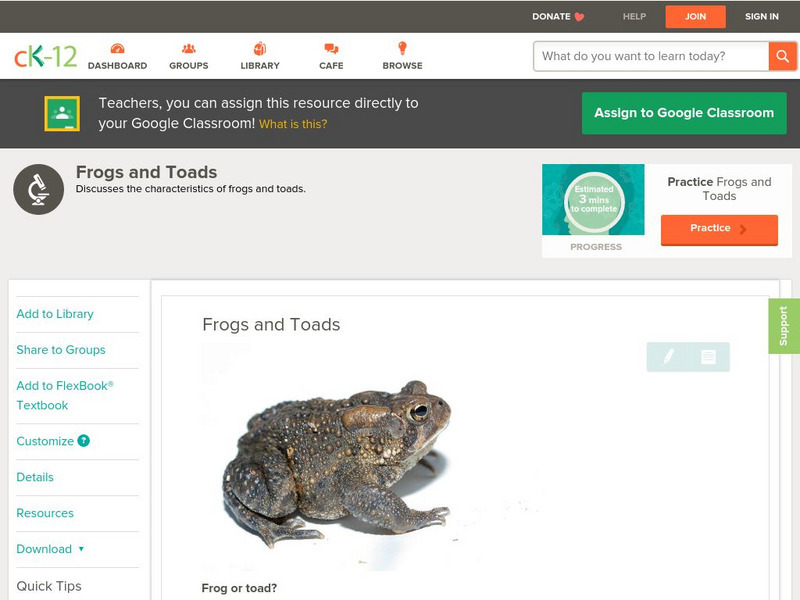Curated OER
Life Science- Learning About Tadpoles
Learners investigate a frog's life cycle. In this tadpole lesson, students observe tadpoles in an aquarium and record results. Learners fill in a KWL chart as an assessment.
Curated OER
The Froggy Page
Students investigate the cycle of life by observing tadpoles. In this biology lesson, students utilize the Internet to read stories, observe pictures, and listen to sounds of frogs. Students create a poster board collage...
Curated OER
Amphibian Spawns
Students observe tadpoles as they gradually change into adults. For this amphibian biology lesson, students watch tadpoles in a tank in the classroom, keep a daily record of what they observe, and chart the growth development of...
Curated OER
Tadpole Diary
Second graders examine the life cycle by observing tadpoles. After reading the book, Tadpole Diary, they draw the stages of tadpole development and write sentences about what they think is happening.
Curated OER
A Frog's Life Story
Students investigate the lives of frogs by completing several worksheets. In this biology instructional activity, students discover the life cycle of a frog from tadpole to death. Students complete frog life cycle puzzle as...
Curated OER
Why So Many Frogs?
Students explain the different stages in the growth of a frog, then analyze and collect data to make generalizations about a larger population. They determine the survival rate of a population of tadpoles under controlled conditions.
Curated OER
Life Cycle of a Frog
Learners investigate the life cycle of a frog. In this biology lesson, students read the book From Tadpole to Frog and use templates to identify the stages of the frog life cycle. Learners draw the life cycle of the frog on construction...
Curated OER
Amphibians
In this amphibian worksheet, students will review the characteristics of the class Amphibia, including frogs and toads, salamanders, and caecilians. This worksheet has 3 short answer questions, 5 matching questions, 6 multiple choice,...
Curated OER
Fishes and Amphibians
In this fish and amphibian learning exercise, students will compare a diagram of an invertebrate chordate with a diagram of a fish and complete 2 short answer questions. Then students will name four characteristics that allow amphibians...
Curated OER
Amphibians
Fourth graders Make flashcards for the following words, memorize them and get quizzed by the teacher: Amphibian, Lungs, complete metamorphosis, tadpoles, tail-less, tail, vertebrate, cold-blooded, gills, swamp, pond.
Curated OER
Amphibians Crossword Puzzle
In this biology worksheet, students complete a crossword puzzle with 24 questions about different types of amphibians and functions of their body parts.
Curated OER
Scientists Breed See-Through Frogs
Students participate in a pre-reading activity, then read a news article about the breeding of transparent frogs. In this biology and current events lesson, the teacher introduces the article with a question and a vocabulary activity,...
Curated OER
Amphibians
In this amphibian worksheet, students read about the frog life cycle to complete the Venn diagram. They also answer 16 fill in the blank questions about frogs.
Curated OER
Using a Questionnaire as a Tool for Management
Young scholars survey other students, teachers, and administrators, using a provided questionnaire, to see what environmental problems the school may have. Young scholars then compile the results, post the results, and decide what the...
Curated OER
The Salmon Estuary And Human Impacts
Students have discussions and complete activities about the pacific salmon life cycle and marine parasites. For this salmon lesson plan, students complete activities such as observing sea lice, playing a tag game, and a board game.
Curated OER
Changing How Things Look
Third graders use a literature study in order to investigate how organisms effect an ecosystem. They are asked questions about change taken from the book. Students also take a nature walk to make field observations.
Curated OER
Invertebrate Chordates
Most chordates are easy to identify because of the specific classification criteria of their phylum. But what about tunicates? Young scientists read a short explanation about why tunicates, or sea squirts, are considered to be members of...
What happened to the frogs?
Students will select ten rubber frogs and determine their pollutant source based on their malformations. Students will write a brief essay on their findings. Students will be engaged in the lesson the entire time!
Curated OER
Growing Eyeballs
Students investigate vision and the anatomy of the human eye. They complete a Webquest, watch a video about the structure of the eye, take an online quiz, answer discussion questions, and read newspaper articles about activities that...
CK-12 Foundation
Ck 12: Life Science: Human Sperm
[Free Registration/Login may be required to access all resource tools.] Sperm, the male reproductive cells, are tiny. In fact, they are the smallest cells in the human body. Some people think that they look like tadpoles. Learn more...
Curated OER
Science Kids: Science Images: Frog Metamorphosis
This drawing shows the metamorphosis of a frog. The five different images each show a stage in the development from tadpole to fully grown frog.
CK-12 Foundation
Ck 12: Life Science: Frogs and Toads
[Free Registration/Login may be required to access all resource tools.] Frogs and toads are amphibians in the order Anura. In terms of classification, there is actually not a big difference between frogs and toads. Learn more about frogs...





















